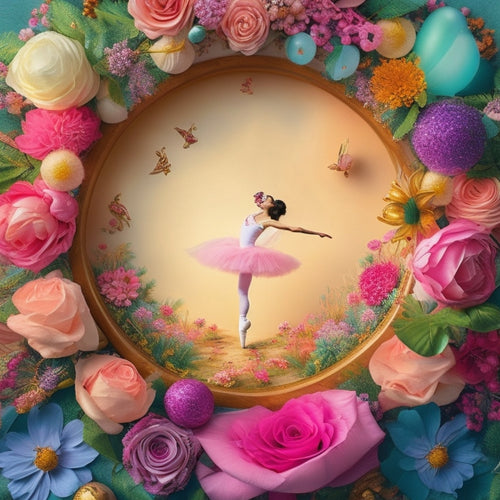
Library of Congress Preserves Ballroom Dance Legacy
Share
The Library of Congress has undertaken a meticulous preservation effort to safeguard the cultural legacy of ballroom dance, recognizing its profound impact on society and culture. This endeavor guarantees the long-term availability of historical resources, providing unparalleled access to researchers and the general public. The library's vast repository of public domain works offers a treasure trove for researchers, facilitating in-depth analysis and reflection on the cultural significance of ballroom dance. As the library continues to preserve and make accessible these valuable resources, a richer understanding of this cultural heritage awaits discovery.
Key Takeaways
• The Library of Congress preserves the cultural legacy of ballroom dance, safeguarding historical resources for long-term availability and research.
• The library's repository of public domain works provides unparalleled access to historical materials for in-depth research and analysis.
• The meticulous preservation of historical dance resources enables a richer understanding of ballroom dance as a cultural heritage and its impact on society.
• The library's efforts facilitate a deeper understanding of the cultural significance of ballroom dance, reflecting societal conventions, etiquette, and morals of its era.
• The preservation of ballroom dance legacy inspires future innovators and provides valuable insights into the collective cultural heritage, shaping social norms and aesthetic preferences.
Preserving Dance Heritage for Generations
Through its meticulous preservation of historical dance resources, the Library of Congress safeguards an essential component of cultural heritage, guaranteeing that the rich legacy of ballroom dance endures for generations to come.
The Library's dedication to dance preservation underscores the historical significance of this art form, recognizing its profound impact on society and culture.
By safeguarding these resources, the Library of Congress secures that future generations can appreciate and learn from the evolution of ballroom dance.
This preservation effort not only honors the past but also inspires future innovators, fostering a deeper understanding of the cultural context in which this dance form emerged.
Public Domain Resources for Research
The Library of Congress's vast repository of public domain works, including the Handbook of Ball-Room Dancing, offers a treasure trove of resources for researchers, scholars, and enthusiasts to explore the rich cultural heritage of ballroom dance. These resources provide unparalleled access to historical materials, facilitating in-depth research and analysis.
By leveraging preservation techniques, the Library of Congress guarantees the long-term availability of these resources, allowing researchers to contextualize ballroom dance within its historical context. Scholars can investigate the cultural and social nuances of the era, while enthusiasts can gain a deeper appreciation for the evolution of ballroom dance.
Through these public domain resources, the Library of Congress fosters a deeper understanding of this enthralling art form.
Cultural Significance of Ballroom Dance
Beyond its mesmerizing spectacle, ballroom dance has played a profound role in shaping social norms, reinforcing cultural values, and reflecting the aesthetic preferences of its time.
Throughout history, ballroom dance has been a mirror to the societal conventions, etiquette, and morals of its era. The tradition of ballroom dance has been passed down through generations, with each era leaving its mark on the dance form.
From the grandeur of the waltz to the sensuality of the tango, ballroom dance has been a reflection of the cultural and social nuances of its time.
As a cultural artifact, ballroom dance offers a unique window into the past, providing valuable insights into the history and tradition of our collective cultural heritage.
Frequently Asked Questions
Are Library of Congress Collections Available for Public Access?
While Library of Congress collections are theoretically available for public access, research barriers and access inequality can hinder utilization, emphasizing the need for equitable dissemination of knowledge and cultural resources.
Can I Use Handbook of Ball-Room Dancing for Commercial Purposes?
"Absence of evidence is not evidence of absence," and in this case, the absence of copyright protection does not guarantee unlimited commercial use. Handbook of Ball-Room Dancing, as a public domain work, may be used commercially, but within fair usage limits, respecting copyright laws.
Is Picryl.Com an Official Library of Congress Website?
PICRYL.com, a digital archive, is not an official Library of Congress website, despite offering public domain content; it operates independently, fostering government partnerships and preserving cultural heritage through accessible digital archives.
How Can I Support the Preservation of Public Domain Works?
With over 70% of public domain works remaining inaccessible, supporting their preservation is vital; consider digital donations to reputable organizations and engage in cultural advocacy to guarantee these treasures remain freely accessible for future generations.
Are All Library of Congress Materials Accessible Online?
Not all Library of Congress materials are digitally accessible online, although efforts are underway to expand digital archives, enhancing online accessibility for the public to explore and utilize these cultural and historical resources.
Related Posts
-

Design Costumes Like a Pro in 5 Essential Steps
To design costumes like a pro, start by upcycling materials and exploring thrift stores for hidden gems. Next, welcom...
-

Dance Moms' Must-Have: Stylish College Hoodie
As a dance mom, embracing a lifestyle of comfort and style is essential, and that's where the must-have stylish colle...
-

Ballet Cut File Set: Versatile Designs Available
The Ballet Cut File Set offers a wide-ranging collection of versatile designs available in multiple formats, includin...


